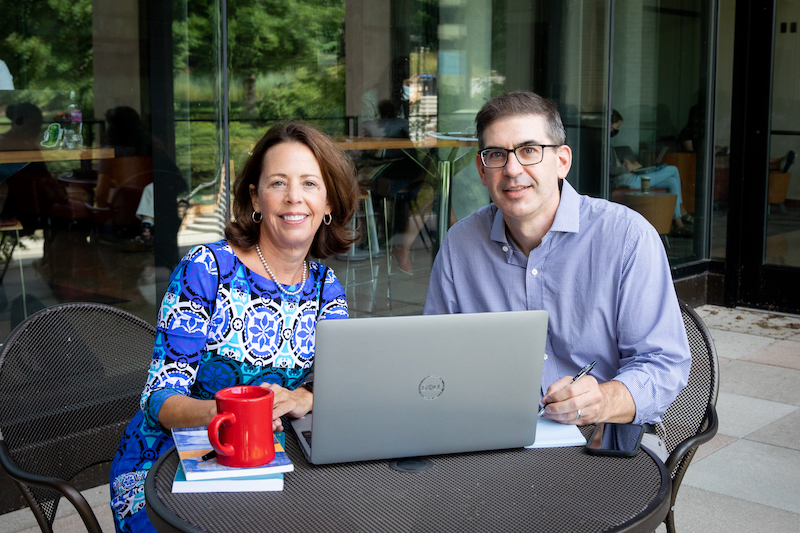Diana Hess still clearly recalls the shock, fear, and sadness felt on campus and across the United States following the terrorist attacks of Sept. 11, 2001.
Hess was an assistant professor at UW–Madison at the time and was scheduled to teach a course that evening — with some of her students in that class training to become social studies teachers.
“I was wondering if I should cancel,” recalls Hess, who today is dean of the School of Education. “But some of these students urged me to hold the lecture because they were going to be teaching the next day in area middle and high schools. They wanted advice on how to talk about the attacks with their students.”
By the next day, Hess was already starting to collect lesson plans about the events that were being disseminated by curriculum organizations and newspapers.
“I was curious about how this would be represented and taught,” she says.

Flash-forward 20 years and this work isn’t merely a distant memory for Hess. It has been ongoing. Since 2002, Hess and Jeremy Stoddard have researched how the events of 9/11 and the global war on terror are integrated into secondary level U.S. classrooms and curricula — and they’ve provided help to educators looking for guidance and resources on how best to teach about it.
Stoddard, who is a professor and chair of the secondary education program in the School of Education’s Department of Curriculum and Instruction, was a graduate student at UW–Madison at the time of the 9/11 attacks and began his PhD in the fall of 2002, when he started collaborating with Hess on this work.
“Working in a department that trains teachers, this research is important because it can impact how things are taught in the field and how people think about historical issues,” says Stoddard.
The research team initially looked at how 9/11 and its aftermath were presented in supplemental curriculum and textbooks. In 2011, Stoddard became the principal investigator and this work pivoted to analyzing 9/11 in state standards documents. In 2018, a survey was created that collected information from social studies teachers to find out how they taught about 9/11 and its aftermath, what materials they used, and what objectives they were trying to accomplish.
For the 20th anniversary of 9/11 this past fall, Stoddard and Hess summarized what they have learned in a report published in The Conversation, spoke with several media outlets about their research, and helped launch a website (teaching911beyondtwenty.wisc.edu) that hosts a resource guide for teachers to draw from for lessons about the 9/11 terrorist attacks, the events leading up to these attacks, and the events in response to them.
In the survey that Stoddard and Hess conducted among 1,047 U.S. secondary school teachers in 2018, they found that while teachers view the attacks of 9/11 as significant, they described challenges with making time to discuss the events — as they are often not a part of standard curricula.
When the events are taught in the classroom, the research shows how educators tend to focus on 9/11 as a shocking attack, while also noting the heroism of first responders, and how the world supported the U.S. in its pursuit of terrorists.
While Hess and Stoddard say that honoring the victims and helping students understand the magnitude of what took place that day is important, they also believe there are risks in teaching “a simple nationalistic narrative of heroism and evil.” Stoddard explains that such a narrative avoids deeper inquiry into the historic role of the U.S. in the Middle East and Afghanistan. It also doesn’t help students understand many of the more controversial subjects with direct links to 9/11, such as Guantanamo Bay and debates about the use of torture, the Patriot Act and government surveillance, and Islamophobia, to name a few.
But there are good reasons such topics were often avoided, with the research showing that teachers report needing help in this realm.
Those surveyed highlighted a lack of quality educational resources and noted anxiety about blowback from parents and the community if they were to engage students in discussions about controversial issues.
In addition to helping to develop the new website that houses re- sources for teachers, Stoddard also hosted workshops over the past year, with a focus on aspects of 9/11 usually left out of lessons.
Stoddard and Hess write in The Conversation: “If the goal of teaching history is to develop citizens who use knowledge of the past to under- stand the present and inform future decisions, educators need to help students learn from 9/11 and the war on terror, and not just about them. This means going beyond the facts of the day and the collective memory aspects to also engage in inquiry into why they happened and how the U.S. and other nations reacted.”